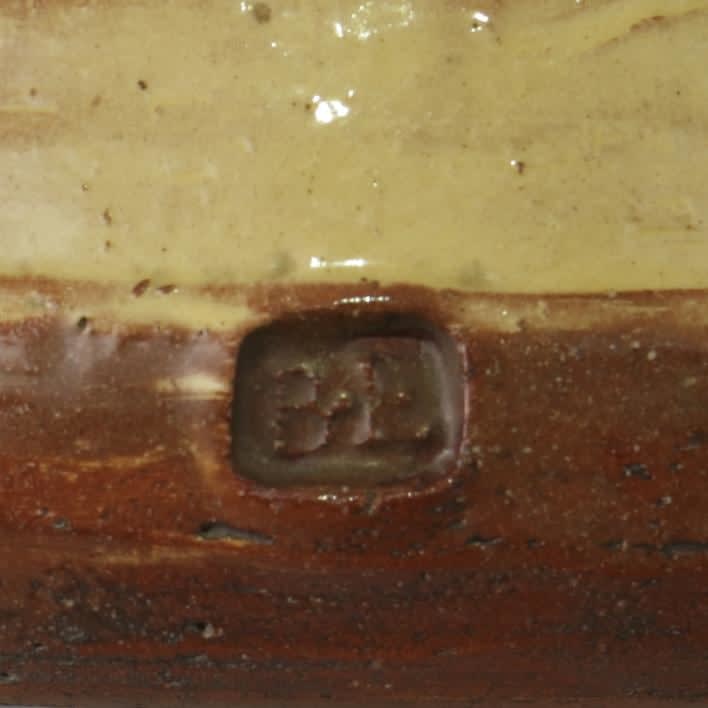Bernard Leach (1887–1979)
Vase
Ceramic
Marked “BL” on the side of the bottom
With a box signed by the artist (1934), double boxed
W16.7 x H47 cm
Further images
In April 1934 (Showa 9), Bernard Leach came to Japan for the fourth time. He used this occasion to share techniques with Japanese potters. He produced pottery at the kilns of potters involved in the Mingei folk crafts movement, including Kawai Kanjiro in Kyoto, Tomimoto Kenkichi in Tokyo, and Hamada Shoji in Mashiko, for instance, and he also visited and worked at kilns in Fujina in Shimane prefecture, Sakazu in Okayama prefecture, and Futagawa in Fukuoka prefecture. He later wrote the following about the Funaki kiln in Fujina:
...the Fujina Pottery near Matsue, which belongs to a family named Funaki who have produced a lead-glazed ware for upwards of a hundred years. The present representative, with whom I worked for over a month three years ago, has come into contact with Hamada and through him with our old English tradition, by which he has been strongly influenced; but he has not blindly followed either. (A Potter’s Book)
The “three years ago” here refers to the time Leach spent in Japan from 1934–5. This seemingly lead-glazed work was possibly produced during this period. The Japan Folk Crafts Association (Nihon Mingei Kyokai) was established in 1934. Leach interacted with the aforementioned three potters and also with Yanagi Soetsu, the chair of the new body. Through these men, he managed to deepen his understanding of the ceramic techniques passed down through regions across Japan.
At forty-seven centimeters high, this is one of the larger examples of the jar-like objects produced by Leach. It has no painted patterns and its structure seems quite simple. After applying the glaze, though, Leach applied a brush to the object’s surface while turning the potter’s wheel. This has imbued the surface with a unique feel. The brush marks make a three-dimensional impression on the thick yellow glaze, for instance, while the brown clay also peaks out in places. The center of the body rises up slightly, as if to form gently-sloping shoulders. The upper section features vertically-long hollows on three sides. These chime with the pleasant tone of the glaze to lend the object a gentle appearance. The moderate, streamlined lines exude a sense of vitality somewhat reminiscent of a fish. Leach has written the date 1934 on the box, though he has drawn the object in ink on the box’s surface rather than writing out its name. This painting reveals what Leach himself thought were the object’s characteristic features, namely the gentle spindle-like shape, the vertical hollows in the center, the neatly rising mouth area, and the clearly-rendered brush-mark pattern.
Bernard Leach (potter; 1887–1979)
Born in Hong Kong to British parents, Leach spent the first years of his life in Japan. After his studies at the Slade School of Design and later the London School of Art, he moved back to Japan in 1909, enganging in intense artistic exchange with the leaders of the emerging mingei (folk art) movement such as Yanagi Muneyoshi (Soetsu), Tomimoto Kenkichi, and Hamada Shoji. After his return to the United Kingdom in 1920, Leach established his studio in St. Ives. His restrained and graceful style proved of strong impact in the Western world as well as in Japan.
...the Fujina Pottery near Matsue, which belongs to a family named Funaki who have produced a lead-glazed ware for upwards of a hundred years. The present representative, with whom I worked for over a month three years ago, has come into contact with Hamada and through him with our old English tradition, by which he has been strongly influenced; but he has not blindly followed either. (A Potter’s Book)
The “three years ago” here refers to the time Leach spent in Japan from 1934–5. This seemingly lead-glazed work was possibly produced during this period. The Japan Folk Crafts Association (Nihon Mingei Kyokai) was established in 1934. Leach interacted with the aforementioned three potters and also with Yanagi Soetsu, the chair of the new body. Through these men, he managed to deepen his understanding of the ceramic techniques passed down through regions across Japan.
At forty-seven centimeters high, this is one of the larger examples of the jar-like objects produced by Leach. It has no painted patterns and its structure seems quite simple. After applying the glaze, though, Leach applied a brush to the object’s surface while turning the potter’s wheel. This has imbued the surface with a unique feel. The brush marks make a three-dimensional impression on the thick yellow glaze, for instance, while the brown clay also peaks out in places. The center of the body rises up slightly, as if to form gently-sloping shoulders. The upper section features vertically-long hollows on three sides. These chime with the pleasant tone of the glaze to lend the object a gentle appearance. The moderate, streamlined lines exude a sense of vitality somewhat reminiscent of a fish. Leach has written the date 1934 on the box, though he has drawn the object in ink on the box’s surface rather than writing out its name. This painting reveals what Leach himself thought were the object’s characteristic features, namely the gentle spindle-like shape, the vertical hollows in the center, the neatly rising mouth area, and the clearly-rendered brush-mark pattern.
Bernard Leach (potter; 1887–1979)
Born in Hong Kong to British parents, Leach spent the first years of his life in Japan. After his studies at the Slade School of Design and later the London School of Art, he moved back to Japan in 1909, enganging in intense artistic exchange with the leaders of the emerging mingei (folk art) movement such as Yanagi Muneyoshi (Soetsu), Tomimoto Kenkichi, and Hamada Shoji. After his return to the United Kingdom in 1920, Leach established his studio in St. Ives. His restrained and graceful style proved of strong impact in the Western world as well as in Japan.







